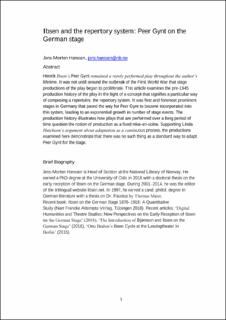| dc.contributor.author | Hanssen, Jens-Morten | |
| dc.date.accessioned | 2021-12-03T13:36:21Z | |
| dc.date.available | 2021-12-03T13:36:21Z | |
| dc.date.created | 2020-12-08T10:00:36Z | |
| dc.date.issued | 2020 | |
| dc.identifier.citation | Theatre research international. 2020, 45 (2), 143-159. | |
| dc.identifier.issn | 0307-8833 | |
| dc.identifier.uri | https://hdl.handle.net/11250/2832804 | |
| dc.description.abstract | Henrik Ibsen's Peer Gynt remained a rarely performed play throughout the author's lifetime. It was not until around the outbreak of the First World War that stage productions of the play began to proliferate. This article examines the pre-1945 production history of the play in the light of a concept that signifies a particular way of composing a repertoire, the repertory system. It was first and foremost prominent stages in Germany that paved the way for Peer Gynt to become incorporated into this system, leading to an exponential growth in the number of stage events. The production history illustrates how plays that are performed over a long period of time question the notion of production as a fixed mise en scène. Supporting Linda Hutcheon's argument about adaptation as a continuous process, the productions examined here demonstrate that there was no such thing as a standard way to adapt Peer Gynt for the stage. | |
| dc.language.iso | eng | |
| dc.title | Ibsen and the repertory system: Peer gynt on the German stage | |
| dc.type | Peer reviewed | |
| dc.type | Journal article | |
| dc.description.version | acceptedVersion | |
| cristin.ispublished | true | |
| cristin.fulltext | postprint | |
| cristin.qualitycode | 2 | |
| dc.identifier.doi | 10.1017/S0307883320000061 | |
| dc.identifier.cristin | 1857282 | |
| dc.source.journal | Theatre research international | |
| dc.source.volume | 45 | |
| dc.source.issue | 2 | |
| dc.source.pagenumber | 143-159 | |
